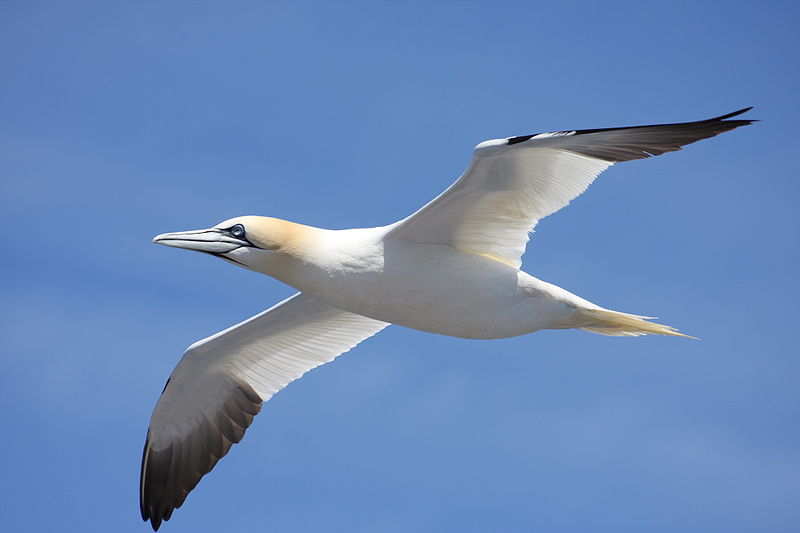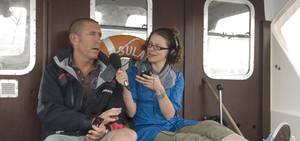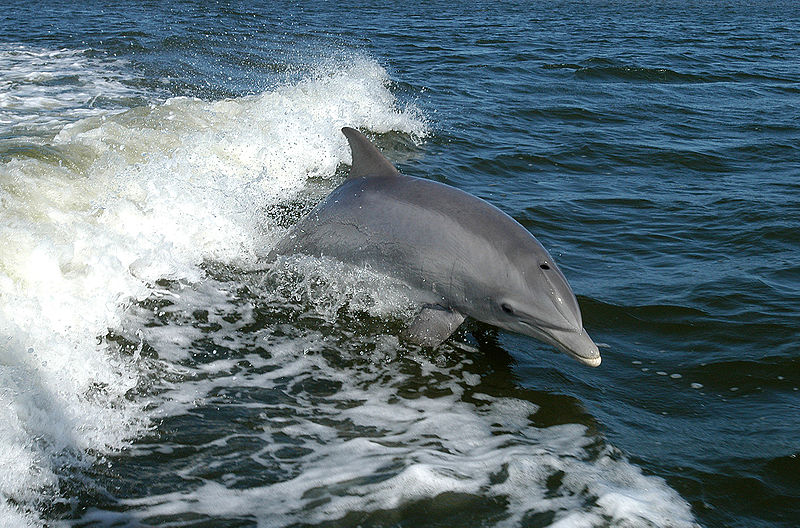Dolphins and bird life in Cardigan Bay
Interview with
Onboard a survey vessel with the Cardigan Bay Marine Wildlife Centre, Helen catches up with some ocean celebrities living in a marine reserve off the Welsh Coast.
 Find out More
Find out More
Cardigan Bay Marine Wildlife Centre
Cardigan Bay Special Area for Conservation
Helen - Well I'm currently bobbing about on the Irish Sea in Cardigan Bay off the west coast of Wales. And I'm on a survey boat. I've joined the Cardigan Bay Marine Wildlife Centre on one of their daily trips out into the bay to track down and see if they can find any of the wonderful marine life that lives in the bay. I;m with various members of the public who come along and help with these surveys. And I guess we'll just have to wait and see what we find, while holding on very carefully so that we don't fall in because the waves are quite big today...
Well, we have our first sighting. It's a bit far away and it's pretty choppy, but we're pretty confident that it's a bottlenose dolphin. Possibly a mother with its calf, which means we have to be particularly careful and not get too close.
No I still can't see it. Ah yes, there it is! Yes, there was a dark fin just appeared and disappeared in the waves. Oh there it is, yes! Fantastic! It's a mother and a calf. Wonderful, a new baby dolphin came to say hello. How nice. And there it is again, yey! It came up really close that time.
The water is sort of... Oh... [laughter] Oh dear, I missed that. Luckily it didn't get me but that was an enormous wave. Two of the kids are now absolutely soaked but they seem to be quite enjoying that so I think that's alright. I'm glad I asn't standing over there. I'm not in my wetsuit. Much fun being had by all.
We've come across and we're actually just looking for some of the marine birds that live in the area too. This is a really important nesting site for lot sof marine birds, and lots of auks apparently. We don't have any puffins, but we have lots of things like guillemots, and kittiwakes, cormorant and shags, and various other winged creatures that also enjoy this area of wales, this very biodiverse and productive part of the country.
We just saw a gannet diving into the sea with it's amazing wide wings. It just turned around and dropped into the water like an arrow. I think it caught something too. Beautiful.
We've just come into the harbour now, we've moored up so it's nice nad smooth away from the waves. And I've maaged to grab Steve Hartley, who was drivin the boat for us. He is the founder and the manager of the Cardigan Bay Marine Wildlife Centre. And this is a really important part of the British coast isn't it? We've got all sorts of important areas that have been designated in Cardigan Bay.
Steve - This is the first stretch of the British coastline that has bee designated as a Marine Heritage Coast.
Helen - And what does that actually mean?
Steve - Protection wise, the Marine Heritage Coast is more raising awarness than having something that is in law. But the Marine Heritage Coast was designated to raise awareness of the area's unspoilt natural beauty and wide variety of wildlife that we have here. And we're very proud of that designation.
If you come here in May-June when we've got the cliffs absolutely alive a huge variety of different birds nesting, and then you can be just off the headland there and be surrounded by bottlenose dolphins foraging, and then look over on the rocks you'll have Atlantic grey seals hauled out and porpoise further away.
It really is a special area and that's why it was designated Britain's first Marine Heritage Coast. Offshore here now we've got an area that's been designated by Europe as an SAC, that's a Special Area of Conservation, and that area's been designated again primarily because of the bottlenose dolphins we've got here but there's other species also that it's designated for.
Helen - So that is a protected area, there are protection measures to help preserve and protect those dolphins species and the other important creatures in the bay.
Steve - The government are duty bound to make sure that activities in that area, in the SAC, don't threaten those species. And I'm not sure that's always happening.
Helen - You are concerned that there are threats to these species that are ongoing. What are the sort of threats that they're facing?
Steve - There's been scallop dredging in Cardigan in the last 30 years. 30 years ago I worked on a scallop dredger but things went pretty quiet then, because it's very much a boom and bust industry. So we had a lot of activity 30 years ago, things have gone very quiet then for 20 odd years or more and then in the last couple of years we've had quite huge numbers of dredgers coming in dredging in Cardigan Bay.
The year before last we had 80 odd boats come down, huge, of all sizes too, dredging up and down Cardigan Bay. Several groups got together and put in complaints to the British Government saying that surely they're not looking after the SAC properly if they're allowing this to happen.
So last season there was a greatly reduced effort in Cardigan Bay. We had a lot of areas closed to scallop dredgers but they still opened up a box right in the middle of the SAC, a Special Area of Conservation. And everybody knows scallop dredging is one of the most destructive forms of fishing, certainly to the sea bed, that there is.
I know how destructive it is, I've worked on a dredger. I've been there lifting the dredges in, emptying them on the deck, and then shovelling the seabed over the side. It is destructive, there's not two ways about it. And the more it goes on in an area, the more it destroys the sea bed and the habitat and the species that live there.
Helen - And presumably those are all the species that are important for the wonderful big creatures we see at the top of the food chain, the dolphins, the porpoises, they rely on all these smaller creatures that presumably are being destroyed and dug up by these scallop dredgers.
Steve - Well it's all part of, it's the bottom of the food chain. And, you know, if they're dredging up sandbanks out there then we're loosing the sand eels. Well, what relies on the sand eels? The bird colonies rely on the sand eels, the mackerel that come in huge shoals of mackerel, come in and feed on the sand eels. The larger animals feed on the mackerel. It's the whole food chain, and also there's the habitat. They've proved by experiments the more you dredge an area the more it changes the actual seabed itself.
What we need is to thoroughly survey the bay. And if there are areas that we can genuinely say, well these areas can be dredged without long term damage to the broader bay itself then fair enough, let them fish those areas in a sustainable way.
- Previous Hoisting the SkySails
- Next Critter of the Month - European Eel









Comments
Add a comment